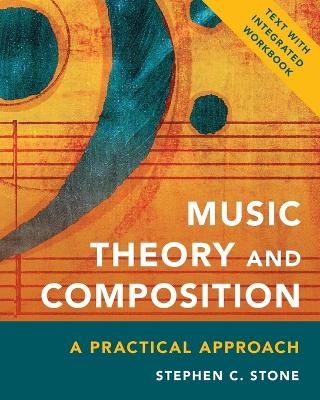
Music Theory and Composition
Rowman & Littlefield (Verlag)
9781538101230 (ISBN)
Music Theory and Composition: A Practical Approachpresents a pragmatic, accessible approach to music theory through an emphasis on melody and counterpoint. This focus explains the “why” of musical construction more clearly than the traditional approach of beginning with chords. By starting with a single melodic line and gradually adding voices in counterpoint, the book drills part-writing while simultaneously explaining functionality, first with scale degrees and then with harmony. The text has students learn musical techniques and progressively build on their functions and importance to create their own compositions.
With short, digestible chapters, Music Theory and Composition clearly presents otherwise complicated ideas not as strict rules, but as artistic ideals, encouraging the interactive creation of new compositions as a tool for learning.
The textbook is versatile and easily customizable, suiting
Different skill levels with species counterpoint providing a framework for the beginner while providing an interesting challenge for more experienced studentsDifferent curricular schedules with complete exercises in two, three, and four voices, allowing for an optional skip from two voices to fourDifferent pedagogical approaches with species exercises encouraging students to consider harmonic choices and figured bass ensuring functional progressions
Instructor Resources:
Instructor’s Manual: The Instructor’s Manual includes sample syllabi and student handoutsTest Bank: The test bank includes sample tests and answer keys in MS Word format.
Student Resources:
Companion Website with Downloadable Workbook Sections: http://textbooks.rowman.com/stone
Additional Features:
complete curriculum for first-year theory coursesover 500 musical examples drawn from Common Practice Era compositions as well as more contemporary and popular piecesfocus on active composition throughout the text and workbook sectionslarge pop music section to expand student’s application of theoryconversational tone to encourage student engagement
Designed for first-year college music theory courses, but accessible enough for the interested lay reader or high school student, the text offers a true balance of counterpoint and harmony.?
STEPHEN C. STONE has been on the music theory faculty at the Peabody Institute of Johns Hopkins University for fourteen years and is the former director of the music program at the Johns Hopkins School of Arts and Sciences.
Preface
A Note for Instructors
A Student’s Introduction
Acknowledgments
Preludes – Rudiments
Prelude 1 – Notation of Sound
Prelude 2 – Meter
Prelude 3 – Scales and Key Signatures
Prelude 4 – Intervals
Prelude 5 – Triads
Prelude 6 – Seventh Chords
Part I – Melody
Chapter 1 – Melodic Construction
Chapter 2 – Major Key Functionality
Chapter 3 – Minor Key Functionality
Chapter 4 – Chromaticism in Melodies
Part II – Species Counterpoint to Chorale Style
Chapter 5 – Background for Species
Chapter 6 – First Species in Two Voices
Chapter 7 – Second and Third Species in Two Voices
Chapter 8 – Fourth Species in Two Voices
Chapter 9 – Fifth Species (Florid Counterpoint) in Two Voices
Chapter 10 – Two-Voice Counterpoint
Chapter 11 – Three Voices and Chords
Chapter 12 – First Species in Three Voices
Chapter 13 – Second and Third Species in Three Voices
Chapter 14 – Fourth Species in Three Voices
Chapter 15 – Fifth Species (Florid Counterpoint) in Three Voices
Chapter 12-15 Redux
Chapter 16 – Four Voice Counterpoint and Chorale Style
Chapter 17 – Figured Bass
Chapter 18 – Other Dissonances
Chapter 19 – The Purpose of Chorale Style
Part III – Diatonic Harmony to Form
Chapter 20 – Roman Numerals and Harmonic Progressions
Chapter 21 – Tonic and Dominant: The Fundamental Relationship
Chapter 22 – Predominants: The Basic Progression
Chapter 23 – Intensifying the Motion: Adding Dissonance
SeventhsCadential 6/4Chapter 24 – Submediant
Chapter 25 – Mediant
Chapter 26 – Harmonic Rhythm
Chapter 27 – Harmonizations
Chapter 28 – Linear Chords
Chapter 29 – Sequences
Chapter 30 – Tonicization
Chapter 31 – Modulation
Chapter 32 – Phrase-level Analysis
Chapter 33 – Small Forms
Part IV – Color Chords and Bold Chromaticism
Chapter 34 – Modal Mixture
Chapter 35 – Neapolitan
Chapter 36 – Augmented Sixth Chords
Chapter 37 – Altered Dominants
Chapter 38 – Enharmonic Reinterpretation
Chapter 39 – Third Relations
Part V – Popular Music
Chapter 40 – Introduction to Popular Music
Chapter 41 – General Stylistic Elements
Chapter 42 – Sonorities from Jazz: Stable Sevenths, Extended Tertian Chords, and Added
Note Harmonies
Chapter 43 – Lead Sheet Notation
Chapter 44 – Pop Progressions Following Classical Diatonic Functions
Chapter 45 – Blues and the Retrogression
Chapter 46 – Mediant and Ascending Thirds
Chapter 47 – Supertonic, Linear Harmonic Motion, and Diatonic Summary
Chapter 48 – Chromaticism from Classical Music
Chapter 49 – Chromaticism from Jazz – Tritone Substitution
Chapter 50 – Pop Chromaticism 1: L and ?VII
Chapter 51 – Pop Chromaticism 2: Quality Change
Chapter 52 – Three Analyses
Appendices
Appendix A – Melodies for Study
Appendix B – Cantus Firmi and Figured Basses for Exercises
Appendix C – Church Modes
Appendix D – Extended Tertian Harmony
Glossary
About the Author
| Erscheinungsdatum | 17.02.2018 |
|---|---|
| Sprache | englisch |
| Maße | 203 x 256 mm |
| Gewicht | 1175 g |
| Themenwelt | Kunst / Musik / Theater ► Musik ► Musiktheorie / Musiklehre |
| ISBN-13 | 9781538101230 / 9781538101230 |
| Zustand | Neuware |
| Informationen gemäß Produktsicherheitsverordnung (GPSR) | |
| Haben Sie eine Frage zum Produkt? |
aus dem Bereich


